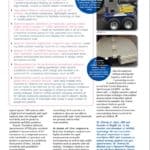RingIR Technology Being Tested by Australian Government
New facilities at the Berrimah Farm Science Precinct offer innovative opportunities to enhance biosecurity surveillance, diagnostics, preparedness and response across northern Australia.
The Australian Government is working closely with the NT government and Top End stakeholders on innovative ways to reduce the impact of costs of managing biosecurity risks.
The new facilities at the Berrimah Farm Science Precinct offer innovative opportunities to enhance biosecurity surveillance, diagnostics, preparedness and response across northern Australia, while offering scope to leverage further investment to support innovative research and development to support the expansion of northern industries.
Minister for Agriculture and Northern Australia David Littleproud said the Berrimah Farm had implemented numerous innovative approaches and technologies to stay ahead of biosecurity risks and reduce costs to industry of incursions by exotic pests and diseases.
“Innovation is critical for Top End biosecurity, that is why we have invested $3.5 million in this facility,” Minister Littleproud said.
“Northern Australia is a high-risk zone for an incursion of exotic pests and diseases such as exotic fruit fly and African swine fever, because of its proximity to countries to our north and the existence of natural biosecurity risk pathways.
“The Australian Government is working closely with the NT government and Top End stakeholders on innovative ways to reduce the impact of costs of managing biosecurity risks.
“This includes through enhancing and expanding how and where detector dogs can be used. Recent trials have shown detector dogs successfully picking up the scent of Citrus Canker and Siam Weed.
RingIR Awarded $3.9 Million to Accelerate ID of Dangerous Chemicals and Explosives
Defence Innovation Hub grants totalling almost $20 million have been awarded to 10 local businesses based in Victoria, NSW, Queensland, Western Australia and the ACT.
The contracts are expected to fund projects aimed at bolstering both Army and Navy capability.
Grant recipients include both SMEs and primes, with BAE Systems Australia among the businesses to secure funding.
Victoria-based RingIR has been awarded the largest contract ($3.9 million), to fund the development of a portable device designed to accelerate the identification of dangerous chemicals and explosives.
Read the full article at DefenceConnect
Ring-IR Receives $4.6 Million Contract to Develop Counter-IED Technology
Minister for Defence Industry, the Hon Christopher Pyne MP, today announced New South Wales-based company RingIR Pty Ltd, would receive $4.6 million to develop and demonstrate an innovative technology to enhance Defence capability.
Minister Pyne said he through the Defence Innovation Hub funding RingIR would develop a counter-improvised explosive device (IED) capability, which uses highly sensitive laser spectrometry technique to locate and identify the vapours exuded from explosives.
“This technology could be used to determine the location and type of IED, allowing Australian Defence Force (ADF) personnel to effectively respond to improvised threats,” Minister Pyne said.
Profile in Explosives Analysis
Click to enlarge | PDF version
- Page 1
- Page 2
- Page 3
Pulsed quantum cascade laser based hypertemporal real-time headspace measurements
Optical cavity enhancement is a highly desirable process to make sensitive direct-absorption spectroscopic measurements of unknown substances, such as explosives, illicit material, or other species of interest. This paper reports advancements in the development of real-time cavity ringdown spectroscopy over a wide-bandwidth, with the aim to make headspace measurements of molecules at trace levels. We report results of two pulsed quantum cascade systems operating between (1200 to 1320)cm−1 and (1316 to 1613)cm−1 that measure the headspace of nitromethane, acetonitrile, acetone, and nitroglycerin, where the spectra are obtained in less than four seconds and contain at least 150,000 spectral wavelength datapoints.
Real-time FPGA data collection of pulsed-laser cavity ringdown signals
This paper presents results from a pulsed-laser cavity ring-down spectrometer with novel field programable gate array real-time data collection. We show both theoretically and experimentally that the data extraction can be achieved from a single cavity ringdown event, and that the absorbance can be determined without the need to fit the ringdown time explicitly. This methodology could potentially provide data acquisition rate up to 1MHz, with the accuracy and precision comparable to nonlinear least squares fitting algorithms.
Pulsed quantum cascade laser-based CRDS substance detection: real-time detection of TNT
This paper presents experimental results from a pulsed quantum cascade laser based cavity ringdown spectrometer used as a high-throughput detection system. The results were obtained from an optical cavity with 99.8% input and output coupling mirrors that was rapidly swept (0.2s to 7s sweep times) between 1582.25 cm−1 (6.3201μm) and 1697.00 cm−1 (5.8928μm). The spectrometer was able to monitor gas species over the pressure range 585 torr to 1μtorr, and the analysis involves a new digital data processing system that optimises the processing speed and minimises the data storage requirements. In this approach we show that is it not necessary to make direct measurements of the ringdown time of the cavity to obtain the system dynamics. Furthermore, we show that correct data processing is crucial for the ultimate implementation of a wideband IR spectrometer that covers a range similar to that of commercial Fourier transform infrared instruments.
Nonlinear estimation of ring-down time for a Fabry-Perot optical cavity
This paper discusses the application of a discrete-time extended Kalman filter (EKF) to the problem of estimating the decay time constant for a Fabry-Perot optical cavity for cavity ring-down spectroscopy (CRDS). The data for the estimation process is obtained from a CRDS experimental setup in terms of the light intensity at the output of the cavity. The cavity is held in lock with the input laser frequency by controlling the distance between the mirrors within the cavity by means of a proportional-integral (PI) controller. The cavity is purged with nitrogen and placed under vacuum before chopping the incident light at 25KHz and recording the light intensity at its output. In spite of beginning the EKF estimation process with uncertainties in the initial value for the decay time constant, its estimates converge well within a small neighborhood of the expected value for the decay time constant of the cavity within a few ring-down cycles. Also, the EKF estimation results for the decay time constant are compared to those obtained using the Levenberg-Marquardt estimation scheme.
Frequency domain analysis for laser-locked cavity ringdown spectroscopy
In this paper we report on the development of a Fourier-transform based signal processing method for laser-locked Continuous Wave Cavity Ringdown Spectroscopy (CWCRDS). Rather than analysing single ringdowns, as is the norm in traditional methods, we amplitude modulate the incident light, and analyse the entire waveform output of the optical cavity; our method has more in common with Cavity Attenuated Phase Shift Spectroscopy than with traditional data analysis methods. We have compared our method to Levenburg-Marquardt non linear least squares fitting, and have found that, for signals with a noise level typical of that from a locked CWCRDS instrument, our method has a comparable accuracy and comparable or higher precision. Moreover, the analysis time is approximately 500 times faster (normalised to the same number of time domain points). Our method allows us to analyse any number of periods of the ringdown waveform at once: this allows the method to be optimised for speed and precision for a given spectrometer.








